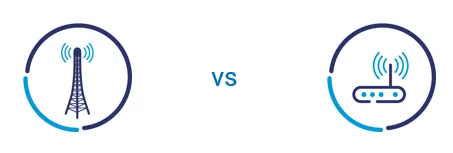
With the recent hype on 5G, an interesting question could be raised, namely: will a mobile system finally become an alternative to fixed access?
Can we really answer that question at this point? As of now, we cannot say for sure what 5G will become, since its still being discussed, the requirements specification is ongoing, and the actual 5G standardization has not yet started. But there are some indications, based on which we can guess to certain extent, what are the possible scenarios for the network evolution under the “5G” umbrella.
5G – an alternative to “home WiFi”?
To try to answer this issue, the following items are extracted from the NGMN whitepaper[1] (which can be treated as one of the “foundation” paper on 5G):
- It is foreseen, that 5G will address Fixed-Mobile Convergence in a much deeper way than previous generations. The aim is to design a system which will be independent on the access technology, with the possibility to add new technologies in a “plug-and-play manner” with an independent evolution tracks of the RAN and Core Network;
- In terms of spectrum access, 5G is expected to cover licensed access, as well as dynamically licensed shared and unlicensed spectrum usage (including both WiFi and LTE in unlicensed spectrum), thus being cheaper than today’s fully licensed mobile networks;
- Extreme densification (with the use of so called Ultra Dense Networks, where the ISD can be as low as 10-50meters) and unplanned deployments is also one of the considered track for 5G, further improving the capacity of the network;
- One of the 5G requirements is to create a flexible, scalable and software based system. The Software Defined Networking (SDN) with Network Functions Virtualization (NFV) concepts fits very well here, where many network functions can be deployed on CoTS hardware, thus should be cheaper than the current proprietary, hardware-based 2G-4G technologies;
- Native SON is one of the assumptions for 5G. That should enable fast evolution of the network capacity when/where needed using automated mechanisms.
- As suggested by the NGMN requirements and followed by ITU-R, 5G should address multitude of use cases among which there are “50+Mbps everywhere” and “Ultra-low cost networks”, addressing specifically wide-area coverage and rural areas (of course these are still subject to final refining and prioritization within standardization bodies);
If we now take all of the above into account, it can be projected (but as said in the beginning, at this point we only can speculate) that 5G will become an alternative to fixed access. In fact, this is one of the drivers pushing towards new generation, i.e. to compete with the fixed networks (i.e. “free” WiFi). The reason being that operators nowadays are struggling to get profits, due to carrying less and less traffic via mobile networks, because of the traffic being transferred over WiFi.
[1] NGMN 5G Whitepaper can be reached under here.







The main advantage of Wi-Fi over mobile is a possibility to connect number of devices (smartphones, computers, laptops, printers etc.) in the same personal (secured) network with the Internet access. Will 5G allow to create such personal network?
Thanks for your comment.
I believe there are at least several aspects related to that, when we speak of 5G:
– “out there” there is a concept of a “virtual user” where the “UE” in its legacy sense is distributed among different devices belonging to a single individual/person. In such a configuration the “distributed user” from the network perspective is seen as a single entity, but internally the devices are interconnected to share data and connectivity according to needs and radio quality of each link. As an example, mobile phone may have better CP coverage from mobile network, while a laptop provides better link to Small Cell with high capacity, but they together cooperate (forward packets/signalling) to setup a joint connectivity having D2D link.
– The end-user’s 5G-AP/Small Cell should enable to create a personal network with local offload;
– 5G can be providing an last mile connection to “tethering/relays” in a similiar way it is done by the e.g. current MiFi;
– WiFi is envisioned to be part of the converged 5G RAN.
But again, we don’t know yet how 5G will look like.
Best,
Marcin